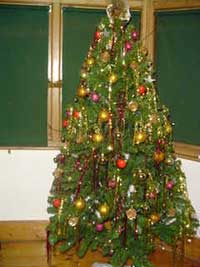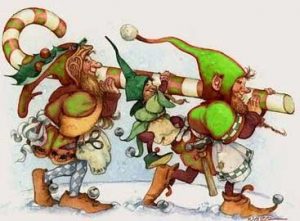Greek Christmas celebrations

Of course something we miss most in southern Greece is the white Christmas but the northern regions have no problem with that as many northern areas of Greece snowy winters every year. For the Greek mother or wife, Christmas is a very busy time in the kitchen.
Almost one week before Christmas, in every Greek house, you can smell the cloves, cinnamon and baked almonds from the Kourambiedes and Melomakarona- the famous Greek Christmas cookies . Big trays with Kourambies, Melomakarona, Nuts, Oranges and Mandarins are part of the Christmas decoration of a Greek living room.
The decorated Christmas tree, artificial or natural, is in many houses many weeks before Xmas with Christmas lights, stars ,angels, and any kind of shining Christmas ornaments. Also, most Greek houses will decorate the exterior of their house with Christmas lights, deers, Carol singing Santas and the latest Xmas decorations.
Almost every balcony is decorated with small illuminated Christmas trees and singing Santa Clauses which are giving a unique, if somewhat kitsch, atmosphere that the country can have only during Christmas and New Year’s Eve.
Christmas Eve is the main day of celebration. From the crack of dawn, children all over Greece get ready for their Carols, equipped with their triangles they go all over the neighbourhoods singing the Kalanda, the Greek Christmas Carol, “Kalin Imera Arhontes an in o Orismos sas Hristou ti Theia Gennisi na Po sto Arhontiko sas” . This means “Good Morning Sovereigns if you allow me in your Mansion I will tell you about the Holy Birth of our Christ”.
After they finish their song people will give them some money and both sides will say the wish “Ke tou Hronou” (Next year again). It is truth that the most beautiful sound of Christmas is the sound of children singing accompanying themselves with their little triangles.

Of course something we miss most in southern Greece is the white Christmas but the northern regions have no problem with that as many northern areas of Greece snowy winters every year. For the Greek mother or wife, Christmas is a very busy time in the kitchen.
Almost one week before Christmas, in every Greek house, you can smell the cloves, cinnamon and baked almonds from the Kourambiedes and Melomakarona ( the famous Greek Christmas cookies ). Big trays with Kourambies, Melomakarona, Nuts, Oranges and Mandarins are part of the Christmas decoration of a Greek living room.
Christmas traditions in Greece

In the old days in the neighborhoods of Athens, before the neighborhood roads were paved with asphalt the children were playing with walnuts on the street or in the fields in the same way we played volleyball and marbles, in many squares they set up swings and other festive shows, while producers from villages the neighborhoods driving with a large rod flocks of turkeys for sale
The Christmas boat

The Greek traditional christmas boat is a tradition of the old times of our country, where children with love, joy and creative mind, used to make their own toys, using whatever they had on hand (usually wood and some paper or rags).
Most of the children ended up building the traditional, now, boat, inspired by the long journeys of their loved ones and the nostalgia to see them again. 50 years ago, that is, until the first post-war decade, we met the boat in many Greek houses and in the hands of children who sang carols. Today, this tradition tends to disappear, as it has been replaced by the foreign fir.
In the early 1970s, the issue of removing the Christmas tree and replacing it with the boat was intensely discussed in Greece, as this combined tradition with ecological consciousness.
The issue was certainly not so simple, as unshakable arguments were presented on both sides, with references to ecological issues and suggestions from experts for the use of plants and trees, except fir.
The Christmas tree displaced the traditional boat that the Greeks decorated on Christmas days. In some areas (mainly on the islands) they still decorate “boats”, while in recent years there is a commendable effort of some Municipalities of the country, to restore the custom to its original form, decorating in their squares boats instead of firs.
The Christmas goblins

Some people think that goblins are black, ugly, tall and dry. Others say they wear iron shoes. For others, they have red eyes, goat legs and a hairy body. Each of them has a flaw. Another lame, another crooked or one-eyed, another single-legged or crooked-legged, other crooked, crooked-faced, with a hump or tail.
They are dichotomous beings and quarrelsome and so they can not do a job until the end and leave everything in the middle. That is why they can not harm people, even though this is their great wish. But no matter how much people disagree about what goblins look like, everyone agrees on one thing: their endless stupidity and puppetry.
On Christmas Eve they go up to earth and wait the night to enter the houses. Although they are evil and wicked beings, they can not harm people, which is why women still walk around them and curse them and call them cinderellas, ashes, pimples, etc.
Woe to him who has to go out at night and go to distant work. The goblins appear in front of him in various forms to intimidate or harm him. They tease him, tease him, ride him and dance around him, preventing him from returning home. Their rage, however, is to tease the unfortunate old women above all.
They are very agile, climbing trees, jumping from roof to roof, breaking tiles and making a lot of noise. On the nights of the Twelfth Day they enter the houses from the chimneys, that is why the fireplaces are lit all day long and have a lot of fire, because they are very afraid of it.
